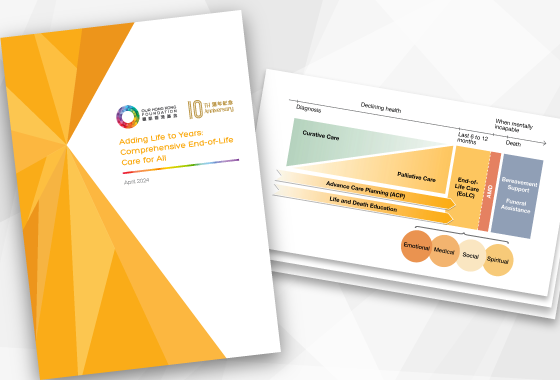Better primary healthcare needed during and beyond the pandemic
This article appeared originally in the China Daily on 12 September, 2022.
Authors: Pamela Tin, Assistant Research Director and Head of Healthcare and Social Development at Our Hong Kong Foundation.

How much have we learned from lessons of the fifth COVID-19 wave? As hopes are dashed for normalcy in a “post-COVID-19” era and the city braces to face the consequences of a new surge in COVID-19 cases, Hong Kong is put right to the test.
While public hospitals curtail non-emergency services and government clinics cut down clinic sessions, citizens are reminded of health and social service gaps exacerbated earlier during the fifth wave such as fragmented community-based services outside the hospital setting and inadequate access to care for chronic conditions. Only this time, experience should have given us a head start in planning for the worst where fundamentally, strategizing for the emerging battle comes hand in hand with addressing the longstanding fundamental inadequacies of the local health system.
In planning for better population health for Hong Kong during and beyond COVID-19, attention must be given to resource allocation to cater to the most pressing health needs of the population, particularly through enhancing primary care services and a recalibration of the public-private service mix to ensure efficient service delivery.
The fifth wave of COVID-19 in Hong Kong was marked by a series of service inefficiencies, particularly within the primary healthcare (PHC) landscape. The hospital-centric health system struggled to meet the demands of non-COVID care despite service availability in the private sector and capacity to supplement care outside of hospitals. Ideally, a stronger primary care ecosystem could have pushed for quicker vaccination uptake and education, early detection of infection, and onward referral where necessary, as well as the provision of mental health support for at-risk populations. A stronger focus on PHC ensures that patients with less-severe or less-urgent needs can conveniently access community-based services and subsequently relieve the growing demand on hospitals.
A significant factor for existing inefficiencies is the dearth of primary care services within the public sector. Despite recent increases in the number of public sector community-based services, almost 70 percent of primary care outpatient consultations are offered in the private sector, which is unaffordable to many. Furthermore, available public-sector primary care services have yet to achieve their goals of shifting the locus of care toward the community and away from hospitals. For instance, District Health Centres (DHCs) were launched in 2019 and immediately challenged by emergent pandemic-related healthcare needs. While DHCs have conducted health promotion and education outreach, vaccination campaigns, and distributed anti-epidemic products, how DHCs can be best leveraged to combat non-COVID health concerns during the COVID-19 pandemic deserves attention. Especially as the Hospital Authority (HA) faces increasing COVID-19 cases and requires greater capacity to meet demand, the health system would benefit from better use of community-based services and stronger private sector participation in relieving care burden.
Role of strategic purchasing in addressing health service gaps
While Hong Kong builds up the PHC ecosystem in the public sector, the high volume of primary care services within the private sector opens a window of opportunity to leverage upon existing services for patients. Previous efforts to leverage private sector services through public-private partnerships (PPPs) have shown promise, with the ever-use rate reaching 98 percent in 2020 for all eligible individuals in the Elderly Health Care Voucher Scheme, which links elders to primary care services within the private sector. Nonetheless, these PPPs have yet to make significant strides in increasing PHC uptake and health promotion. It will be important to incorporate strategic purchasing principles into PPPs to improve the alignment of investments toward the public’s imminent health needs, particularly now as HA service demand for COVID-19 care increases and attention turns to leveraging the private sector’s resources.
At its core, strategic purchasing centers on investing public funds in a way that directly and exactly meets population health needs, particularly toward services that have yet to be provided in a timely manner. During this critical juncture, the government needs to better grasp the needs of citizens and how the private sector may best align with these demands. Specifically, using strategic purchasing as a health financing lever for Hong Kong’s PHC development, the public and private sectors can be better integrated to target services with long-wait times that aim to improve chronic conditions. This differs from budgetary allocations for a range of services or carving out funds for a broad health goal. Health system planners can utilize public funds to attain private sector primary care services that are deemed efficacious and cost-effective. Crucially, strategic purchasing advances health system sustainability through the prioritization of population health needs in service access, integration of existing services, and investment optimization for contracted services.
Strengthening health system for long-term sustainability
Strategic purchasing can be used to bridge the gaps in PHC service provision that have been highlighted during the COVID-19 pandemic. During the process of developing a strategic purchasing plan, policymakers can clearly elucidate what services the private sector is capable of fulfilling to meet population health needs. In the long term, the direct outcome of strategic purchasing in expanding the range of PHC services is a wider variety of services available to those who relied on the public sector, in a cost-efficient manner that reduces patients’ financial burden. Increased options for PHC can offer an extra buffer of health protection via shorter wait times and more convenient care in the community. The true benefit is that the baseline health of the public may be elevated, and in the long term, fewer costly health services are needed, thus ensuring system sustainability.
Strategic purchasing is thereby key to primary healthcare development and overall health system sustainability, during and beyond the COVID-19 pandemic. As Hong Kong looks forward to the new chief executive’s inaugural Policy Address, it is crucial that policymakers return to the recently released framework of the city’s blueprint for primary healthcare development and apply strategic purchasing, as they have previously stated their intentions to do, for expedited PHC development to safeguard the health of our citizens.



